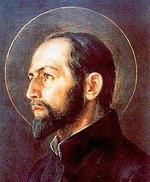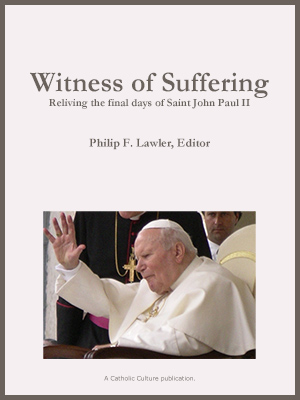Upcoming Calendar Highlights: Pentecost Week Edition
By Jennifer Gregory Miller ( bio - articles - email ) | May 26, 2023 | In The Liturgical Year
The End of the Easter Season, and beginning of Ordinary Time
This Sunday the Church celebrates the Solemnity of Pentecost marking the closing of the Easter season. Personally it has been a busy Easter season. I can’t help note that the shift of liturgical seasons also marks the the end of the school year and the beginning of summer, which have a different “flavor” and schedule to it.
Even though I’ve been more busy than usual, I’ve been following my spiritual director’s advice to let the joy of the Resurrection “wash over me” and really take root in my soul. If we have all been doing so during this past 7 weeks of Easter, it should be apparent that while liturgically it doesn’t look like Easter, the Resurrection should have changed and molded our hearts. The reality and impact of the Resurrected Christ on me should be carried out throughout the next part of the Liturgical Year, Ordinary Time.
A few highlights for Pentecost Week:
Sunday, May 28: The Solemnity of Pentecost
-
Pentecost is fifty days after Easter, and completes the Easter cycle. Pentecost is the bookend of the Easter season, and the liturgy echoes much of the Easter liturgy. Take some time to meditate over the readings of the long form for the the Vigil of Pentecost, and compare it to the Easter Vigil.
-
In the previous liturgical calendar there was an octave of Pentecost. There are still vestiges of it remaining, without it being an official “octave.” For example, the day after Pentecost is the relatively newer Memorial of Mary, Mother of the Church, in some areas the Pentecost Ember Days are observed on Wednesday, Friday and Saturday after Pentecost, and the Sunday after Pentecost always closes with Trinity Sunday, honoring the work of the Father, Son and Holy Spirit…a fitting closing to Pentecost. There are also the traditional station churches marking the days after Pentecost until Trinity Sunday.
-
There are Jewish links to our Christian Pentecost. Shavuot is the Jewish Pentecost. It commemorates God giving of the Torah (the first five books in the Hebrew Bible) to Moses at Mount Sinai. It is also traditionally known as the Feast of Weeks, since it is 7 weeks or 50 days after Passover.
The original Jewish celebration was a harvest festival, often called “Festival of Harvest” brining in the first fruits of the winter harvest to the Temple in thanksgiving to God. After the destruction of the Second Temple, the focus became more on the celebration of the gift of the Covenant from God.
-
It might be fun to incorporate some of traditional Jewish foods for Pentecost. Usually they would eat dairy foods on the first day of Shavuot, remembering the description of Israel as a “Land flowing with milk and honey.” Cheesecake and cheese blintzes are usual treat. A fruit salad or strawberries served over cheesecake sounds like a perfect Pentecost treat.
-
This has been the season of celebration of the sacrament of Confirmation in our diocese (Arlington in Virginia). I love these craft ideas to focus on the gifts and fruits of the Holy Spirit, and in preparation or celebration of Confirmation!
- The Cenacle Project
- Pentecost Wheel
- Visual Display
- Try fun ideas incorporating different elements of fire and wind, such as a windsock, balloons, pinwheels, etc.
-
How about a Pentecost Picnic?
- My previous posts on Pentecost:
May 31, June 2 and 3, Pentecost Ember Days
- Wednesday, Friday and Saturday after Pentecost marks the traditional Summer or Pentecost Embertide. These Ember Days fall during the week after Pentecost (the traditional octave of Pentecost), near the summer solstice. The three focal points for the Ember Days of this period of the year are: 1) to ask God to bless especially the wheat harvest, 2) to thank God for the season of summer, and 3) to ask for special graces for those being ordained as priests during this season.
- See my previous posts on Pentecost Ember Days:
Monday, May 29, Memorial of the Blessed Virgin Mary, Mother of the Church
Monday is Memorial of Mary, Mother of the Church. Think of the apostles and disciples as neophytes after the outpouring the Holy Spirit. How much they must have depended on Our Lady in the early beginnings of the Church and the spreading the Good News. Let this feast day help us turn to our Mother of the Church to ask for her love and guidance as live our vocation and apostolate.
Wednesday, May 31, Feast of the Visitation of the Blessed Virgin Mary
It is not often that the Church celebrates two feasts of Our Lady in one week. Wednesday is the Feast of the Visitation of Mary, when she traveled to visit her cousin Elizabeth, who was carrying St. John the Baptism already for six months.
- I love reading Mary Reed Newland’s reflections on the Visitation.
- I often think that this feast reminds us how important it is to have strong friendships that support us.
- But it is also a feast that reminds me of keeping things in my heart. I don’t have to share everything that is going on with me. God will provide the time and place for me to share what is necessary.
Sunday, June 3: The Solemnity of the Most Holy Trinity
At the close of the Pentecost week we have Trinity Sunday. See my post Celebrating Trinity Sunday at Home for some celebration ideas.
Return to Ordinary Time
After Pentecost the liturgy returns to the Eighth Week in Ordinary Time. I have been preparing the next three summer months for Catholic Culture’s Liturgical Year section. Ordinary Time has more “room” for saints’ days and other feasts. There will be five solemnities in June alone. I find the summer months exciting because we have the full gamut of biblical saints, both from the Old and New Testament, early Christian martyrs, and saints from all walks of life, and different centuries, including the past century.
I don’t want to repeat myself too much, so here are my previous posts reflecting on this time of the year or Ordinary Time:
- Return to “Tempus Per Annum” or Ordinary Time
- Our Summer Plans and Work in Ordinary Time
- Our Ordinary Walk of Life: Understanding “Tempus per Annum”
- Summer: More Time for the Lord, Not a Vacation from Him
All comments are moderated. To lighten our editing burden, only current donors are allowed to Sound Off. If you are a current donor, log in to see the comment form; otherwise please support our work, and Sound Off!








